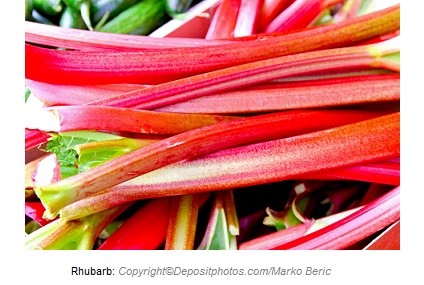Rhubarb is a vegetable from Polygonaceae family. The leaves are toxic, and the stems  are only edible parts. One cup of chopped rhubarb contains 6 grams of carbohydrates, 2 grams of fiber and 1 gram of protein.
are only edible parts. One cup of chopped rhubarb contains 6 grams of carbohydrates, 2 grams of fiber and 1 gram of protein.
Average calories: 28 per one cup, chopped.
|
Rhubarb: one cup, chopped |
|
|
Carbohydrate |
6 |
|
Fiber |
2 |
|
Protein |
1 |
|
Fat |
0 |
|
Calories |
28 |
Vitamins found in higher amounts: vitamins K, C, B9, and B2.
Minerals found in higher amounts: calcium, potassium, manganese and magnesium.
Phytonutrients found in higher amounts and their health benefits: the phytochemicals in rhubarb are phenolic compounds (catechins, caffeic acid, ferulic acid, fumaric acid and gallic acid), flavonoids (quercetin, rutin and anthocyanins), lutein, pectins, rhaponticin, rhapontigenin and sennosides.
Flavonoids and phenolic compounds are potent antioxidants with anti-inflammatory, anti-cancer and immune-boosting properties. The color of the vegetable results from anthocyanins.
Lutein is the predominant carotenoid that has a key role in having healthy eyes. It has an antioxidant activity as well.
Rhaponticin and rhapontigenin are glucosides that improve liver function and blood sugar level, showing anti-diabetic activity. According to few recent studies, they may slow down the progression of Alzheimer’s disease.
Sennosides, emodin and rhein are the anthraquinones found abundantly in rhubarb. They are laxatives and cathartics.

